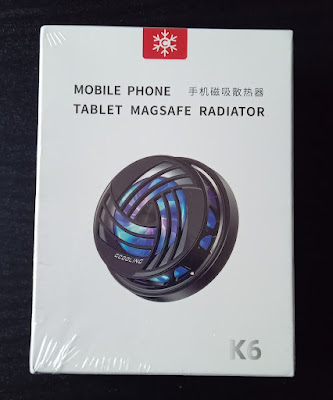Some people use mobile phones for gaming or watching movies which require the phone to be active for long periods of time, and particularly in the case of gaming on a phone, there is considerable SOC activity which generates heat.
In order to prevent overheating of the phone a number of companies have developed cooling systems which can be attached by magnetic means to the phone. Some of these systems have TEC cooling and a fan.
This experiment involves the use of a phone cooling device to cool the case of a ZWO ASI178MC 14 bit planetary Colour CMOS camera. The ASI178MC has a 1/1.8″ and 6.4M pixels sensor IMX178 with SONY STARVIS and Exmor R Technology with a pixel Size of 2.4µm. Although it is an uncooled camera, it does have a temperature sensor along with a flat back with no recesses which together made it suitable for this experiment. The aim was to see whether the cooler significantly cooled the camera and whether a significant difference was made to the thermal noise generated by the camera.
The ZWO ASI178MC has a perfectly flat back with no recessed areas and it has a diameter of 6 cm. The mobile phone cooler chosen was the Yodoit K6 Portable Magsafe Magnetic Mobile Phone TEC Cooling LED Radiator, Silent Smart Battery Protecting Semiconductor Heat sink. This device has a diameter of exactly 6 cm which makes it suitable. (It should be noted that there are other similar devices that have the same diameter and even have settings for different levels of cooling). The device was purchased from Amazon for less than £20.
The boxed cooler
Contents of the product box
The cooler takes power via a USB C connector via the supplied cable. We connected the cable to a Mains powered USB plug.
The cooler connects to the camera via a self-adhesive magnetic disk of 6cm diameter. This is required because the camera body is aluminium.
The back of the ASI178MC camera
The magnetic disk is stuck to the back of the camera
The cooler is held firmly to the magnetic disk by magnetism
The cooler is held firmly so it will not fall off but can be easily slid off the back of the camera.
Side view of the assembly
This view shows the USB C port for powering the cooler.
Bench testing was done by mounting the camera-cooler assembly on a Capped off refractor
When the power to the cooler is turned on, LEDs that continually change colour light up in the cooler and the fan spins up silently carrying heat away from the hot junction of the TEC cooler.
AstroDMx Capture was used to stream images from the camera. It was set to 16 bit, fully debayered, 30s exposure at 250 gain.
Ambient temperature was 22oC. The camera temperature took 30 minutes to reach 30oC.
AstroDMx Capture streaming data from the camera at 30oC
If you look carefully, you will see that the preview shows significant noise in the dark exposure.
A 16 bit FITS snapshot was taken and then stretched an exact, reproducible amount.
Stretched snapshot taken at 30oC
The thermal noise is evident after the relatively mild stretching of the dark image.
The power was then connected to the cooling device and the progress of cooling recorded every 5 minutes for 30 minutes.
Graph of the cooling process
It can be seen that after 30 minutes the camera had cooled to about 5oC below ambient. The rate of cooling seemed to be asymptotically approaching an equilibrium.
The camera body was cold to the touch and some condensation was present on the outside of the camera body whilst no condensation appeared on the sensor window during the experiment.
AstroDMx Capture Streaming images at 17.3oC
Stretched snapshot taken at 17.3oC
Little thermal noise is present compared with the identically stretched snapshot taken at 30oC.
Discussion
It is evident that the cooler was able to cool the camera below ambient. How much cooler the camera would have become if the cooler was left switched on for more time is not known, but the graph does seem to show the temperature was approaching a limit.
It is not known how cool the camera would get if the ambient temperature was something like a winter’s night.
However, in the bench tests reported here it seems that under warm conditions, at least half an hour is required for the camera to cool down. This has to be viewed as a serious limitation of the method. This is particularly true in a climate such as that experienced by the UK, where every moment of clear sky should be taken advantage of.
Another unknown at the present time is whether the optical window of the camera would eventually become covered in dew and how this would be affected by humidity, or even worse (and potentially dangerous to the camera itself), whether dew would start to form inside the camera, or whether the heat generated by the electronics would prevent this from happening.
In the end, the reason for wanting some cooling will determine what is the best approach. If what is required is to prevent the camera from overheating then an air-cooled camera such as the Altair Hypercam 174M Mono Fan-Cooled Astronomy Camera should be chosen or less satisfactorily, an external fan attached as with some Player One cameras. The TEC cooling solution examined here may be chosen to help reduce thermal noise in long exposure deep-sky images when a proper cooled camera is not available.
Nevertheless, the method, in its broadest sense, works; and for this reason field tests will be justified to see what kind of deep sky images can be obtained.
Any attempts to reproduce the work done here should be done with caution as there is the caveat that any adverse effects that might affect the camera are at this time unknown. For this reason we are NOT recommending this procedure at this stage.












